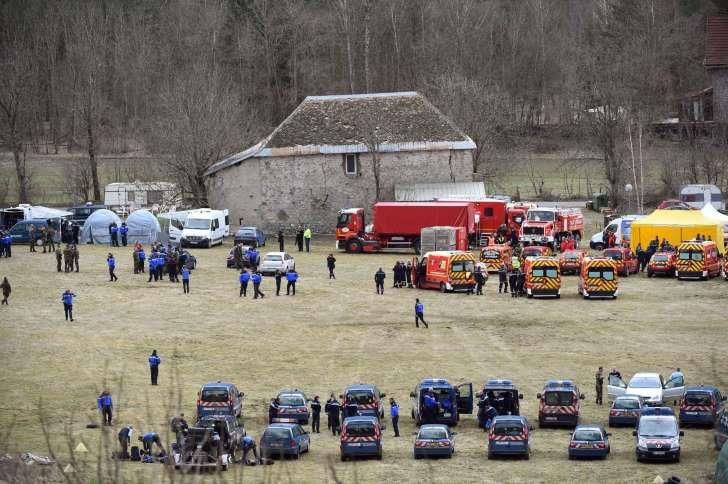March 24, 2015
A “black box” flight recorder has been found at the site of the Germanwings plane crash believed to have killed 150 people, the French interior minister has announced, as the remote location of the disaster continues to hamper the rescue effort.

March 24, 2015
A “black box” flight recorder has been found at the site of the Germanwings plane crash believed to have killed 150 people, the French interior minister has announced, as the remote location of the disaster continues to hamper the rescue effort.

A helicopter flies over the crash scene where debris from the Germanwings A320 plane can be seen. Photograph: Securite Civile/REX
All 144 passengers – including two babies – and six crew on Germanwings flight 4U9525, en route from Barcelona to Düsseldorf, were believed to have been killed.
There was no immediate clue as to the cause of the crash, which happened at around 11am local time on Tuesday in calm weather conditions.
Aviation experts were puzzled as to why the crew reportedly failed to raise the alarm as the plane dropped from the sky and changed trajectory to avoid smashing into the mountain.
On Tuesday afternoon, the French Prime Minister, Manuel Valls, said a helicopter had succeeded in landing near the crash site but had found no survivors. He said “no hypothesis” could be ruled out about the cause of the tragedy.
The dead are believed to include 45 Spanish and 67 German nationals. A school party of 16 German teenagers returning from an exchange trip to Spain were booked on the plane but school officials could not say if the group had boarded.
A helicopter flies over the crash scene where debris from the Germanwings A320 plane can be seen © Provided by Guardian News A helicopter flies over the crash scene where debris from the Germanwings A320 plane can be seen
The German chancellor, Angela Merkel, who plans to travel to the crash site on Wednesday, said the crash had plunged Germany, France and Spain into “deep mourning”.
One witness, Sebastien Giroux, said he saw the plane flying very low in the southern Alps near Digne-les-Bains, near where it crashed.
“There was no smoke or particular sound or sign of anything wrong, but at the altitude it was flying it was clearly not going to make it over the mountains,” he told BFM-TV. “I didn’t see anything wrong with the plane, but it was too low.”
The plane, operated by Lufthansa’s low-cost subsidiary Germanwings, had taken off from Barcelona at 10.01 local time. It was just under halfway through its journey to Düsseldorf, where it had been expected to land at 11.55am, when it began to lose altitude.
French emergency services workers (back) and members of the French gendarmerie gather in Seyne, south-eastern France, on March 24, near the site where a Germanwings Airbus A320 crashed in the French Alps.

Germanwings plane crash in the French Alps
The French aviation regulatory authority (DGAC) said the aircraft did not issue a distress call, as initially reported, but that its sudden drop in altitude had led air traffic controllers to implement the “distress phase”. This is the third and most serious of three alerts used to help identify and coordinate rescue efforts when a plane is thought to be in difficulty.
The chief executive of Germanwings, Thomas Winkelmann, told a press conference: “At 10.35am the plane had reached 38,000 feet, but after 10 minutes it was in downfall and was losing altitude. That lasted eight minutes. The contact with the aircraft with French radar was lost at 10.53am at which point the plane was around 6,000ft. The plane then crashed.”
Germanwings confirms crash as relatives await news
Afterwards, there was conflicting information over the timings. The flight tracking website FlightRadar24 claimed the plane started dropping at 10.31am, fell 31,000ft in nine minutes and vanished off the radar at 10.40am.
Aviation experts questioned Winkelmann’s suggestion the plane had stalled, saying that, while its descent was rapid, the crew appeared to have some control until shortly before the crash.
Rescue helicopters located the wreckage soon afterwards in the grey, stony cleft of a mountain range high in the southern French Alps, between Digne-les-Bains and Barcelonnette.
Hundreds of gendarmes, firefighters and emergency search and rescue teams, as well as 10 helicopters and a military aircraft, were dispatched to the crash site to search for survivors.
The crash zone is isolated, extremely difficult to reach and completely inaccessible to vehicles. Rescuers were unsure if they would arrive before nightfall, when weather conditions were expected to deteriorate, but officials said there was little hope of finding anyone alive.
Local councillor Gilbert Sauvan, who flew over the crash site, said there was “very little left of the aircraft”.
“The biggest pieces must be the size of a car, no bigger,” Sauvan said. “I would say there was no chance of finding anyone who survived.”
Florent Plazy, director of the local ski school ESF, confirmed the area was hard to access, even for mountain walkers, and said the rescue operation would be “extremely complicated”.
Pierre Polizzi, the owner of a campsite near where the plane crashed, said he heard the plane making strange noises shortly before it disappeared.
“I heard a series of loud noises in the air. There are often fighter jets flying over, so I thought it sounded just like that. I looked outside, but I couldn’t see any fighter planes,” Polizzi told the Associated Press. “The noise I heard was long, like eight seconds, as if the plane was going more slowly than military plane speed. There was another long noise after about 30 seconds.”
Polizzi said the plane crashed around 3-11 miles (5-8km) north of his camp. “It’s going to be very difficult to get there. The mountain is snowy and very hostile.”
The French government set up an emergency centre and sent the interior minister, Bernard Cazeneuve, to the scene.
President François Hollande said: “The causes of the accident are not yet known but suggest no survivors. I would like to send all our solidarity to the family of the victims.”
He said he was in regular communication with Merkel and King Felipe VI of Spain, who was visiting the Elysée Palace in Paris at the time of the crash, but cut short his state visit after the news broke.
“It’s a new air tragedy; we must know all the causes. We are in mourning because this accident happened on our territory,” Holland said.
The Airbus A-320-211 named “Mannheim” with the registration D-AIPX, was at the end of its commercial flying life, according to La Provence newspaper. Its first flight was on 29 November 1990 and it had been flown commercially by Lufthansa/Germanwings since 1991.
The Germanwings president said: “The last checkup for the plane was in March at Düsseldorf by our technical teams. The last major checkup laid down by Airbus procedure was in summer 2013.”
He said the captain of the plane had more than 10 years’ experience with Lufthansa and Germanwings, and 6,000 hours of flight on the Airbus.
A spokesperson for the British Prime Minister, David Cameron, said: “He has been informed of this tragic news of the aircraft that has been lost over southern France and he would wish to express how his thoughts are very much with the families and friends of all of those who were on that flight.
“If there is any assistance or role that UK air accident investigators can play in response to this then of course the French and German forces will have our full support and engagement on that.”
Courtesy: The Guardian
















































































































